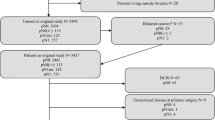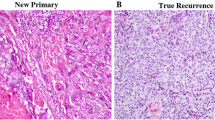Abstract
To compare the outcome of patients with invasive breast cancer, who had isolated tumor cells (ITC) in sentinel lymph nodes, pN0(i+), to patients with histologically negative nodes, pN0. We retrospectively studied 1,273 patients diagnosed with T1–T3 breast cancer from 1999 to 2009. Patients were divided into 2 populations: 807 patients treated with breast-conserving surgery (BCS) and radiotherapy (RT), 85(10.5 %) with pN0(i+) and 722(89.5 %) with pN0. And the other population had 466 patients treated with mastectomy without post-mastectomy radiation therapy (PMRT), 80(17.2 %) with pN0(i+),and 386(82.8 %)with pN0. All patients underwent sentinel node biopsy, and the presence of ITC was determined. Patients with axillary dissection only or neoadjuvant chemotherapy were excluded. Among the 1,273 patients studied; 87.3 % received adjuvant systemic therapy. Kaplan–Meier, Cox regression, and log-rank statistical tests were used. Median patient age was 55.7 years. Median follow-up was 69.5 months. The 5- and 10-year cumulative incidence of Loco-regional recurrence (LRR) for patients treated with BCS and RT was 1.6 and 3.5 % for 85 pN0(i+) patients, and 2.4 and 5 % for 722 pN0 patients, respectively. For patients treated with mastectomy without PMRT, 5- and 10-year LRR rates were 2.8 and 2.8 % for 80 pN0(i+) patients, and 1.8 and 3 % for 386 pN0 patients, respectively. There were no statistically significant differences in LRR (p = 0.9), distant recurrence (p = 0.3) ,and overall survival (p = 0.5) among all groups. On multivariate analysis, ITC were not associated with increased risk of LRR, distant recurrence and overall survival. Grade (p = 0.003) and systemic therapy (p = 0.02) were statistically significantly associated with risk of LRR. Sentinel node ITC have no significant impact on LRR, distant recurrence and overall survival in breast cancer patients. Additional treatments such as axillary dissection, chemotherapy, or regional radiation should not be given solely based on the presence of sentinel node ITC.



Similar content being viewed by others
References
Fisher B, Bauer M, Wickerham DL, Redmond CK, Fisher ER, Cruz AB, Foster R, Gardner B, Lerner H, Margolese R et al (1983) Relation of number of positive axillary nodes to the prognosis of patients with primary breast cancer. An NSABP update. Cancer 52(9):1551–1557
Giuliano AE (1996) Sentinel lymphadenectomy in primary breast carcinoma: an alternative to routine axillary dissection. J Surg Oncol 62(2):75–77. doi:10.1002/(SICI)1096-9098(199606)62:2<75:AID-JSO1>3.0.CO;2-N
Giuliano AE, Hunt KK, Ballman KV, Beitsch PD, Whitworth PW, Blumencranz PW, Leitch AM, Saha S, McCall LM, Morrow M (2011) Axillary dissection vs no axillary dissection in women with invasive breast cancer and sentinel node metastasis: a randomized clinical trial. JAMA, J Am Med Assoc 305(6):569–575. doi:10.1001/jama.2011.90
Warren LE, Miller CL, Horick N, Skolny MN, Jammallo LS, Sadek BT, Shenouda MN, O’Toole JA, Macdonald SM, Specht MC, Taghian AG (2014) The impact of radiation therapy on the risk of lymphedema after treatment for breast cancer: a prospective cohort study. Int J Radiat Oncol Biol Phys 88(3):565–571. doi:10.1016/j.ijrobp.2013.11.232
Cronin-Fenton DP, Ries LA, Clegg LX, Edwards BK (2007) Rising incidence rates of breast carcinoma with micrometastatic lymph node involvement. J Natl Cancer Inst 99(13):1044–1049. doi:10.1093/jnci/djm026
Giuliano AE, Dale PS, Turner RR, Morton DL, Evans SW, Krasne DL (1995) Improved axillary staging of breast cancer with sentinel lymphadenectomy. Ann Surg 222(3):394–399 discussion 399–401
Edge SB, Compton CC (2010) The American Joint Committee on Cancer: the 7th edition of the AJCC cancer staging manual and the future of TNM. Ann Surg Oncol 17(6):1471–1474. doi:10.1245/s10434-010-0985-4
Pugliese MS, Beatty JD, Tickman RJ, Allison KH, Atwood MK, Szymonifka J, Arthurs ZM, Huynh PP, Dawson JH (2009) Impact and outcomes of routine microstaging of sentinel lymph nodes in breast cancer: significance of the pN0(i+) and pN1mi categories. Ann Surg Oncol 16(1):113–120. doi:10.1245/s10434-008-0121-x
Colleoni M, Rotmensz N, Peruzzotti G, Maisonneuve P, Mazzarol G, Pruneri G, Luini A, Intra M, Veronesi P, Galimberti V, Torrisi R, Cardillo A, Goldhirsch A, Viale G (2005) Size of breast cancer metastases in axillary lymph nodes: clinical relevance of minimal lymph node involvement. J Clin Oncol 23(7):1379–1389. doi:10.1200/JCO.2005.07.094
de Boer M, van Deurzen CH, van Dijck JA, Borm GF, van Diest PJ, Adang EM, Nortier JW, Rutgers EJ, Seynaeve C, Menke-Pluymers MB, Bult P, Tjan-Heijnen VC (2009) Micrometastases or isolated tumor cells and the outcome of breast cancer. N Engl J Med 361(7):653–663. doi:10.1056/NEJMoa0904832
Degnim AC, Zakaria S, Boughey JC, Sookhan N, Reynolds C, Donohue JH, Farley DR, Grant CS, Hoskin T (2010) Axillary recurrence in breast cancer patients with isolated tumor cells in the sentinel lymph node [AJCC N0(i+)]. Ann Surg Oncol 17(10):2685–2689. doi:10.1245/s10434-010-1062-8
Maaskant-Braat AJ, van de Poll-Franse LV, Voogd AC, Coebergh JW, Roumen RM, Nolthenius-Puylaert MC, Nieuwenhuijzen GA (2011) Sentinel node micrometastases in breast cancer do not affect prognosis: a population-based study. Breast Cancer Res Treat 127(1):195–203. doi:10.1007/s10549-010-1086-6
Montagna E, Viale G, Rotmensz N, Maisonneuve P, Galimberti V, Luini A, Intra M, Veronesi P, Mazzarol G, Pruneri G, Renne G, Torrisi R, Cardillo A, Cancello G, Goldhirsch A, Colleoni M (2009) Minimal axillary lymph node involvement in breast cancer has different prognostic implications according to the staging procedure. Breast Cancer Res Treat 118(2):385–394. doi:10.1007/s10549-009-0446-6
Reed J, Rosman M, Verbanac KM, Mannie A, Cheng Z, Tafra L (2009) Prognostic implications of isolated tumor cells and micrometastases in sentinel nodes of patients with invasive breast cancer: 10-year analysis of patients enrolled in the prospective East Carolina University/Anne Arundel Medical Center Sentinel Node Multicenter Study. J Am Coll Surg 208(3):333–340. doi:10.1016/j.jamcollsurg.2008.10.036
Tan LK, Giri D, Hummer AJ, Panageas KS, Brogi E, Norton L, Hudis C, Borgen PI, Cody HS 3rd (2008) Occult axillary node metastases in breast cancer are prognostically significant: results in 368 node-negative patients with 20-year follow-up. J Clin Oncol 26(11):1803–1809. doi:10.1200/JCO.2007.12.6425
Karam I, Lesperance MF, Berrang T, Speers C, Tyldesley S, Truong PT (2013) pN0(i+) Breast Cancer: treatment patterns, locoregional recurrence, and survival outcomes. Int J Radiat Oncol Biol Phys 87(4):731–737. doi:10.1016/j.ijrobp.2013.07.028
Taghian A, Jeong JH, Mamounas E, Anderson S, Bryant J, Deutsch M, Wolmark N (2004) Patterns of locoregional failure in patients with operable breast cancer treated by mastectomy and adjuvant chemotherapy with or without tamoxifen and without radiotherapy: results from five National Surgical Adjuvant Breast and Bowel Project randomized clinical trials. J Clin Oncol 22(21):4247–4254. doi:10.1200/JCO.2004.01.042
Carter CL, Allen C, Henson DE (1989) Relation of tumor size, lymph node status, and survival in 24,740 breast cancer cases. Cancer 63(1):181–187
Leidenius MH, Vironen JH, Heikkila PS, Joensuu H (2010) Influence of isolated tumor cells in sentinel nodes on outcome in small, node-negative (pT1N0M0) breast cancer. Ann Surg Oncol 17(1):254–262. doi:10.1245/s10434-009-0723-y
Calhoun KE, Hansen NM, Turner RR, Giuliano AE (2005) Nonsentinel node metastases in breast cancer patients with isolated tumor cells in the sentinel node: implications for completion axillary node dissection. Am J Surg 190(4):588–591. doi:10.1016/j.amjsurg.2005.06.018
Weaver DL, Ashikaga T, Krag DN, Skelly JM, Anderson SJ, Harlow SP, Julian TB, Mamounas EP, Wolmark N (2011) Effect of occult metastases on survival in node-negative breast cancer. N Engl J Med 364(5):412–421. doi:10.1056/NEJMoa1008108
Dowlatshahi K, Fan M, Bloom KJ, Spitz DJ, Patel S, Snider HC Jr (1999) Occult metastases in the sentinel lymph nodes of patients with early stage breast carcinoma: a preliminary study. Cancer 86(6):990–996
Acknowledgments
We would like to acknowledge Rano M. Faltas, MD and Boshra F. Louka, MD for their help in the writing of this manuscript.
Conflicts of interest
No conflict of interest to disclose for all authors.
Author information
Authors and Affiliations
Corresponding author
Rights and permissions
About this article
Cite this article
Keruakous, A.R., Sadek, B.T., Shenouda, M.N. et al. The impact of isolated tumor cells on loco-regional recurrence in breast cancer patients treated with breast-conserving treatment or mastectomy without post-mastectomy radiation therapy. Breast Cancer Res Treat 146, 365–370 (2014). https://doi.org/10.1007/s10549-014-3027-2
Received:
Accepted:
Published:
Issue Date:
DOI: https://doi.org/10.1007/s10549-014-3027-2




